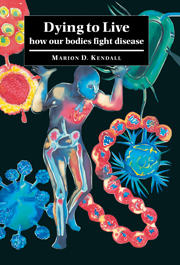4 - Repelling Invaders
Published online by Cambridge University Press: 29 September 2009
Summary
Psoriasis This skin condition, which affects about 2% of the population, often develops in people between the ages of 20 and 30 years who have a certain genetic disposition to develop the disease. This is because of their major histocompatibility complex (MHC) genes in the Cw6 region of chromosome 6 – see Chapter 1. Large scaly lesions form, particularly on the skin of the elbows, knuckles and knees. In severe cases much more of the body becomes affected, so the patient finds it cosmetically embarrassing. About 10% of patients suffer a form of arthritis which flares up as the psoriasis is controlled. At each affected site, the skin cells proliferate rather faster than elsewhere and develop in a slightly different manner, and there are changes underneath that include alterations to the fine blood vessels under the skin, allowing the lesions to bleed easily. Thus the normal skin barrier to the body is weakened at these sites, and bacteria often live in the lesions. One bacterium called Staphylococcus aureus is quite harmful if it gets inside the body. Surgeons are careful to avoid cutting into such psoriatic lesions to prevent the spread of the associated bacteria. The treatment of the disease is difficult but ultraviolet light lessens the severity of the lesions. In some cases, the anti-cancer drugs can be used since they generally reduce cell proliferation and the lesions shrink.
Major Defences
The first and most important protection against invaders is a good barrier to their entry.
- Type
- Chapter
- Information
- Dying to LiveHow our Bodies Fight Disease, pp. 55 - 72Publisher: Cambridge University PressPrint publication year: 1998



